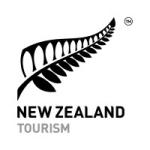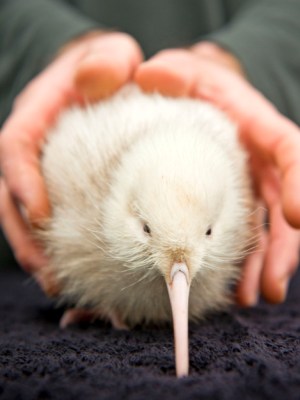Rare white kiwi a good omen
A rare all-white kiwi, thought to be the first ever bred in captivity, has hatched at the Pukaha Mount Bruce National Wildlife Centre in Wairarapa - exciting conservationists and New Zealand Maori who believe it is a special omen.
Manukura - the little white kiwi. from Mike Heydon on Vimeo.
Named ‘Manukura’ which means ‘of chiefly status’ the young chick is not an albino but the rare progeny of kiwi that were transferred to Pukaha from Hauturu/Little Barrier Island near Auckland, last year.
Some kiwi from Little Barrier Island have white markings but no white kiwi were brought over in the transfer and Pukaha staff say Manukura was a the ultimate surprise in what has been the most successful breeding season in the history of the wildlife centre.
Lucky No 13
The little white kiwi was born on 1 May and was the 13th of 14 kiwis successfully hatched at Pukaha Mount Bruce this breeding season - by far the most successful since 2003 when kiwi were reintroduced into the wild there.
The chick was named Manukura by local iwi Rangitane o Wairarapa and tribal elders see it as a ‘tohu’ or sign of new beginnings.
"Every now and then something extraordinary comes along to remind you of how special life is. While we’re celebrating all 14 kiwi hatched this year, Manukura is a very special gift," said Rangitane chief executive and Pukaha board member, Jason Kerehi.
Little chief
Meaning ‘of chiefly status’ the Maori name Manukura also joins the Rangitane people with Ngati Manuhiri, the tribe from Little Barrier Island which helped transfer the 30 kiwi to Pukaha. ‘Kurahaupo’ was a Rangitane waka or canoe. ‘Manu’ means something of high rank and also a bird. Kura means ‘precious’ and also ‘feather’.
Kiwi were transferred from Little Barrier Island last year as part of a plan to increase the kiwi gene pool at Pukaha and grow the population in the long-term.
White kiwi are known to have existed on the island but none were brought to Pukaha so Manukura’s arrival was a big surprise according to Pukaha chairman Bob Francis.
Nocturnal nursery
Manukura is being hand-reared in Pukaha’s new kiwi nursery, part of a recent $1.4 million upgrade of the nocturnal house.
The little white chick will remain in the nursery until the end of May and visitors are able to view it in its nocturnal brooder box as well as when it is weighed each day at 2.00pm.
Manukura will then remain in captivity with other chicks at Pukaha for at least four to six months where, subject to its behaviour and welfare, it will be able to be viewed several times a week while being weighed. When it is old enough to protect itself, it could potentially be released into the sanctuary.
However, Department of Conservation (DOC) rangers, who manage the kiwi programme at Pukaha, will ensure the best interests of the bird remain a priority.
"A white kiwi might really stand out making it more vulnerable," said DOC area manager Chris Lester. We want to ensure that as many people as possible get a chance to see it, and that we keep it as safe as possible. We also recognise the need to take everything into account when deciding how best to keep Manukura safe."
Successful season
Pukaha staff are delighted with the first breeding season involving the Little Barrier kiwi and say it has far exceeded expectations.
Compared to the period between 2005 and 2010 when a total of 10 chicks were hatched and returned to the forest, this season had been a major success, said Bob Francis.
"Faster breeding is exactly what was intended by the transfer, but were blown away by the number of chicks produced so quickly."
Fertile kiwi eggs are retrieved from Pukaha’s 940-hectare native forest and incubated in the kiwi house until they hatch.
Two of this season’s chicks have already been released and 12 chicks at various stages of growth are being held either in the kiwi house nursery or in a predator-proof outdoor enclosure. They will be released when they weigh approximately one kilogram and are large enough to defend themselves.
Pukaha Mt Bruce
The Pukaha Mount Bruce Centre was the first place in New Zealand to use captive breeding for conservation and is now an internationally recognised facility for a number of threatened New Zealand bird species.
Restoration of the Pukaha forest began in 2001 and trapping has allowed the reintroduction of native species into the unfenced reserve - for the first time in almost 100 years.
Kiwi, kokako and kaka have all bred successfully in the wild at Pukaha.
Visitors can enjoy guided tours of the forest, feed eels, see native birds being fed and tour the kiwi house and interactive gallery. Puhaka Mount Bruce is open every day of the year except Christmas Day.
More information
- Pukaha Mt Bruce opens new kiwi experience
- Pukaha Mt Bruce kiwi translocation
- Hi-resolution images of Manukura can be downloaded at http://www.flickr.com/photos/pukahamountbruce/

